8.2 Chemical Weathering
Chemical weathering results from chemical changes to minerals that become unstable when they are exposed to surface conditions. The kinds of changes that take place are specific to the mineral and the environmental conditions. Some minerals, like quartz, are virtually unaffected by chemical weathering. Others, like feldspar, are easily altered.
Types of Chemical Weathering Reactions
Dissolution
Dissolution reactions produce ions, but no minerals, and are reversible if the solvent is removed. A household example would be dissolving a teaspoon of table salt (the mineral halite) in a glass of water. The halite will separate into Na+ and Cl– ions. If the water in the glass is allowed to evaporate, eventually there won’t be enough water molecules to hold the Na+ and Cl– ions apart, and the ions will come together again to form halite. Gypsum and anhydrite are other minerals that will dissolve in water alone. (So don’t rinse off the halite, gypsum, or anhydrite samples in your mineral collection.)
Other minerals, such as calcite, will dissolve in acidic water. Acidic water is common in nature, because carbon dioxide (CO2) in the atmosphere reacts with water vapour in the atmosphere, and with water on land and in the oceans to produce carbonic acid (Figure 8.9).
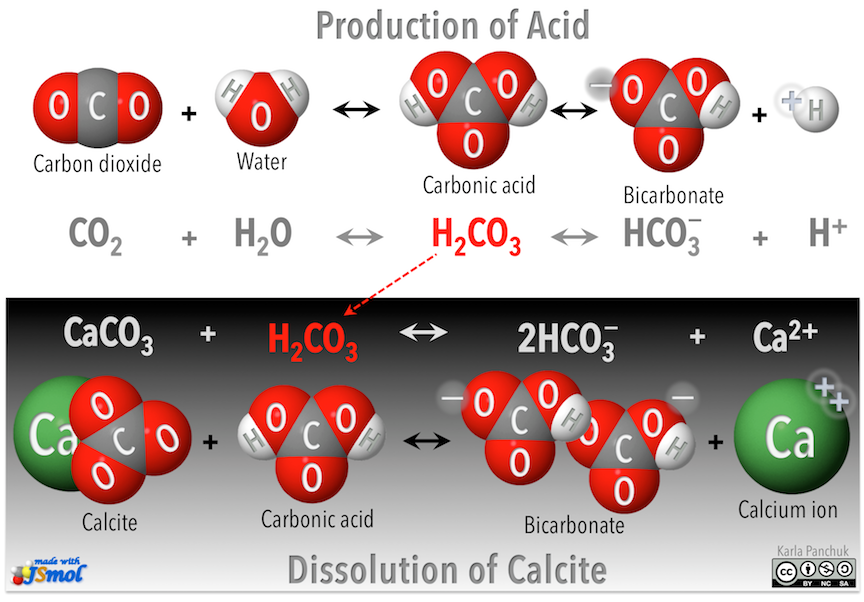
While rainwater and atmospheric CO2 can combine to create carbonic acid, there’s only enough CO2 in the air to make very weak carbonic acid. In contrast, biological processes acting in soil can produce a much higher CO2 concentration within the soil, as well as adding organic acids. Any water percolating through the soil can become significantly more acidic.
Dissolution and Sinkholes
Calcite is a major component (typically more than 95%) of the sedimentary rock called limestone. Acidic groundwater will dissolve limestone, and can eventually remove enough calcite to form caves.
If dissolution of limestone or other materials removes enough rock to undermine support near the surface, the surface may collapse, creating a sinkhole such as the one in Figure 8.10, downstream of the Mosul Dam in Iraq.
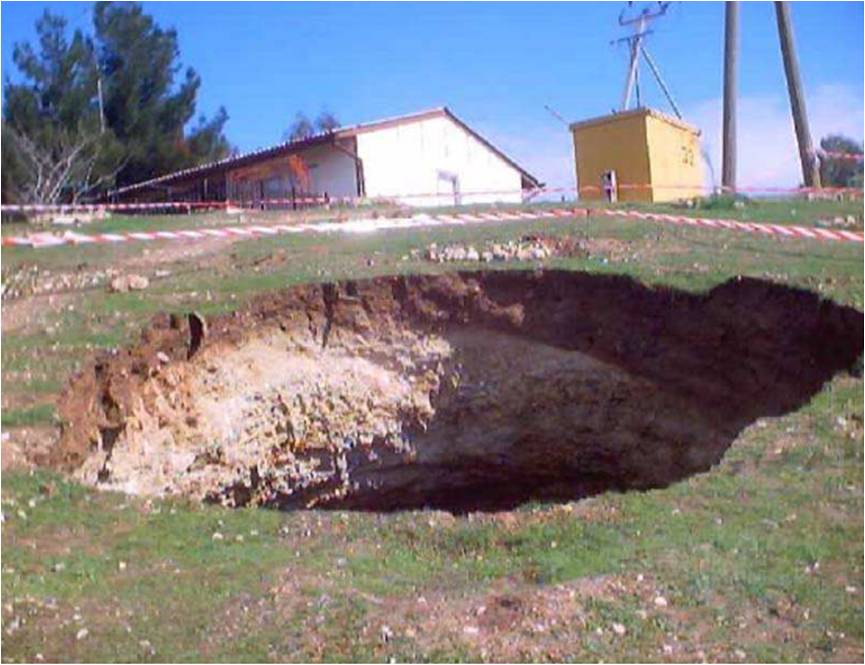
Although the sinkhole might appear minor, it indicates a serious problem for the dam. The dam itself is constructed on limestone supported by beds of gypsum and anhydrite. Gypsum and anhydrite are soluble in water, and the gypsum and anhydrite beneath the dam are rapidly dissolving away. This was the case prior to construction of the dam, but the dam was filled, the problem became even worse. The increased water pressure began to force water through the formations much faster, accelerating dissolution. Ongoing measures to fill gaps with grout are required, or else there is a grave risk of catastrophic failure, placing nearly 1.5 million people at risk.
Hydrolysis
The term hydrolysis combines the prefix hydro, referring to water, with lysis, which is derived from a Greek word meaning to loosen or dissolve. Thus, you can think of hydrolysis as a chemical reaction where water loosens the chemical bonds within a mineral. This might sound the same as dissolution but the difference is that hydrolysis produces a different mineral in addition to ions.
An example of hydrolysis is when water reacts with potassium feldspar to produce clay minerals and ions. The results can be seen by comparing weathered and unweathered surfaces of the same sample of granite (Figure 8.11). On the recently broken unweathered surface (Figure 8.11, left) feldspar is visible as bright white crystals. On a weathered surface (right) the feldspar has been altered to the chalky-looking clay mineral kaolinite.
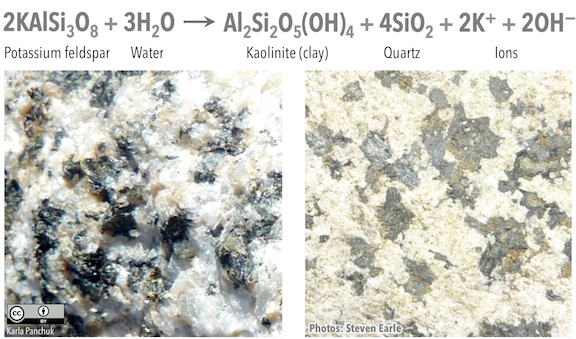
Silicate minerals other than feldspar can undergo hydrolysis, but with different end results. Pyroxene can be converted to the clay minerals chlorite or smectite. Olivine can be converted to the clay mineral serpentine.
Hydration
Hydration reactions involve water being added to the chemical structure of a mineral. An example of a hydration reaction is when anhydrite (CaSO4) is transformed into gypsum (CaSO4·2H2O). A consequence of hydration is that the resulting mineral has a greater volume than the original mineral. In the case of the Mosul Dam, hydration of anhydrite has important consequences. The increase in volume applied force to an overlying limestone layer, breaking it into pieces. While unbroken limestone is a strong enough material upon which to build a foundation, broken limestone is too weak to provide a safe foundation.
Oxidation
Oxidation happens when free oxygen (i.e., oxygen not bound up in molecules with other elements) is involved in chemical reactions. Oxidation reactions provide valuable insight into Earth’s early surface conditions because there’s a clear transition in the rock record from rocks containing no minerals that are products of oxidation reactions, to rocks containing abundant minerals produced by oxidation. This reflects a transition from an oxygen-free atmosphere to an oxygenated one.
In iron-rich minerals such as olivine, the oxidation reaction begins with taking iron out of the mineral and putting it into solution as an ion. Olivine reacts with carbonic acid, leaving dissolved iron, bicarbonate, and silicic acid:
Fe2SiO4 + 4H2CO3 → 2Fe2+ + 4HCO3– + H4SiO4
Iron and oxygen dissolved in water react in the presence of bicarbonate to produce hematite and carbonic acid:
2Fe2+ + ½ O2 + 2H2O + 4HCO3– → Fe2O3 + 4H2CO3
When the olivine in basalt is oxidized, the basalt takes on a reddish colour that’s very different from the dark grey or black of unweathered basalt (Figure 8.12).
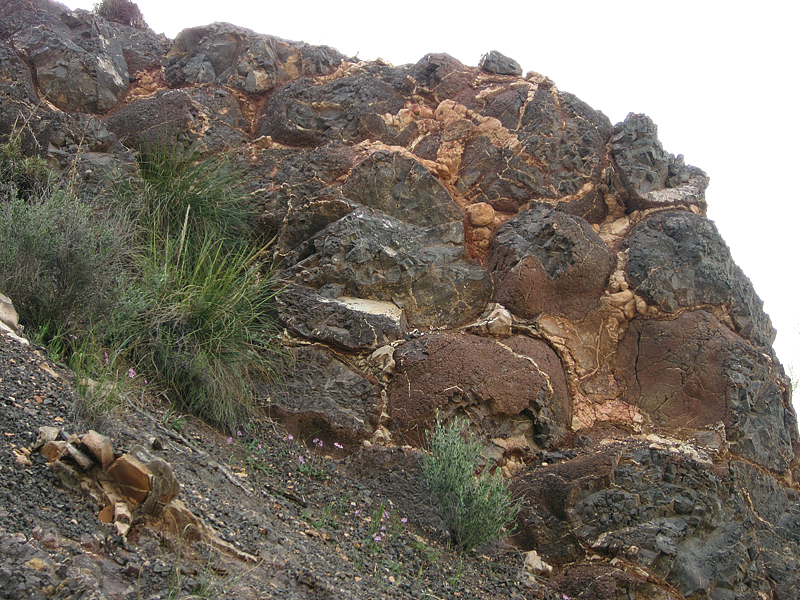
The oxidation reaction would be similar for other iron-containing silicate minerals such as pyroxene, amphibole, and biotite. Iron in sulphide minerals such as pyrite (FeS2) can also be oxidized in this way.
Hematite is only one of may minerals that can result from oxidation. In granite, for example, biotite and amphibole can be altered to form the iron oxide and iron hydroxyoxide minerals that are referred to in combination as limonite (orange material in Figure 8.13).
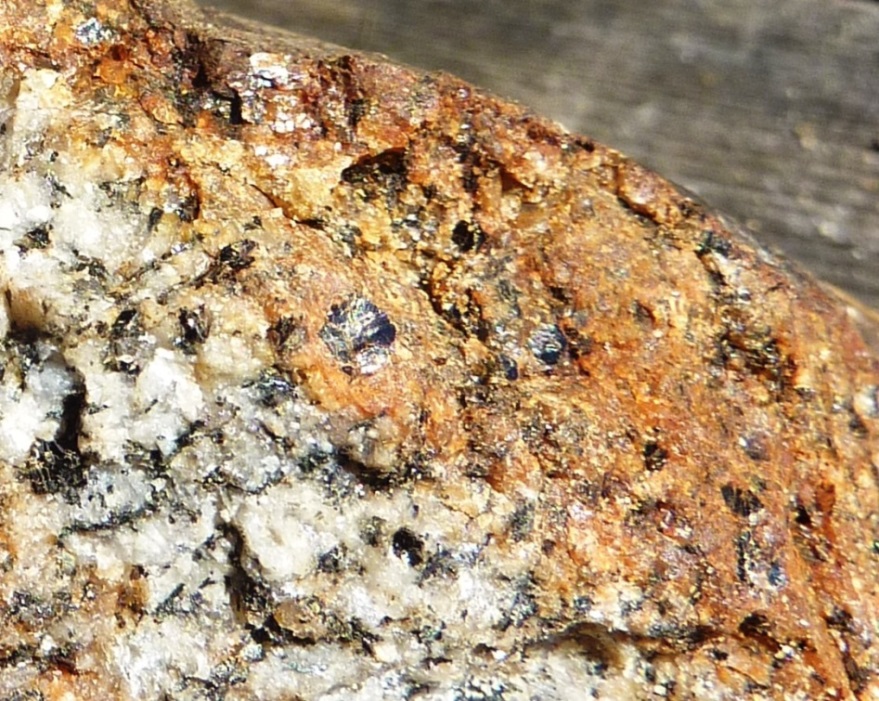
Oxidation Reactions and Acid Rock Drainage
Oxidation reactions can pose an environmental problem in areas where rocks have elevated levels of sulphide minerals such as pyrite. This is because when oxygen and water react with pyrite, sulphuric acid is produced:
2FeS2 + 7O2 + 2H2O → 2FeSO4 + 2H2SO4
The runoff from areas where this process is taking place is known as acid rock drainage (ARD), and even a rock with only 1% or 2% pyrite can produce significant ARD. Some of the worst examples of ARD are at metal mine sites, especially where pyrite-bearing rock and waste material have been mined from deep underground, and then piled up and left exposed to water and oxygen. In these cases the problem is referred to as acid mine drainage. One example is the Mt. Washington Mine near Courtenay on Vancouver Island (Figure 8.12), but there are many similar sites across Canada and around the world.
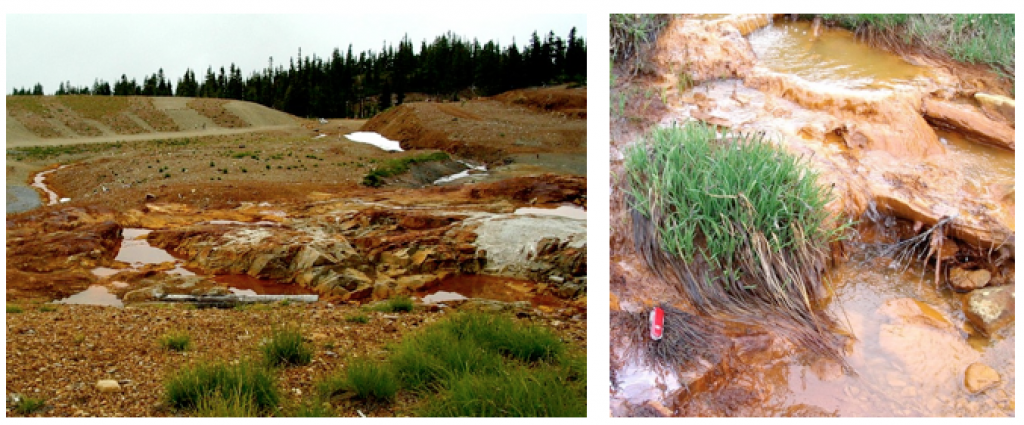
At many ARD sites, the pH of the runoff water is less than 4 (very acidic). Under these conditions, metals such as copper, zinc, and lead easily dissolve in water, which can be toxic to aquatic life and other organisms. For many years, the river downstream from the Mt. Washington Mine had so much dissolved copper in it that it was toxic to salmon. Remediation work has since been carried out at the mine and the situation has improved.
Practice with Chemical Weathering
Match the words into the correct boxes to complete the definitions.
In reactions, minerals turn into ions. Under the right conditions, this reaction can go in the opposite direction and turn the ions back into minerals.
In reactions, water also disrupts chemical bonds, but in this case a new mineral is produced as well as ions.
Water is added to a mineral’s structure in reactions.
In , a mineral is transformed by chemical reactions with oxygen.
Fill-in-the-blank options:
- dissolution
- oxidation
- hydrolysis
- hydration
Now that you’re warmed up, try this:
Which type of chemical weathering—dissolution, oxidation, hydration, or hydrolysis—causes the transformations shown here? Fill in the blanks. If you get stuck, look at the hints.
- Pyrite (FeS2) → Hematite (Fe2O3) (Hint: What’s the difference in the elements making up each mineral?)
- Calcite (CaCO3) → Calcium (Ca2+) and bicarbonate ions (HCO3−) (Hint: Does this transformation produce a mineral?)
- Feldspar (KAlSi3O8) → Kaolinite clay (Al2Si2O5(OH)4) (Hint: Water is a disruptive influence in this transformation)
- Olivine ((Mg,Fe)2SiO4) → Serpentine (Mg, Fe)3Si2O5(OH)4 (Hint: Water is a disruptive influence in this transformation)
- Pyroxene ((Mg,Fe)SiO3) → Limonite (FeO(OH)·nH2O) (Hint: Limonite is an iron oxide)
- Anhydrite (CaSO4) → Gypsum (CaSO4·2H2O) (Hint: What gets added to anhydrite to make gypsum?)
To check your answers, navigate to the below link to view the interactive version of this activity.
References
Bienfait, B., & Ertl P. (2013). JSME: a free molecule editor in JavaScript. Journal of Cheminformatics, 5(24). https://doi.org/10.1186/1758-2946-5-24

